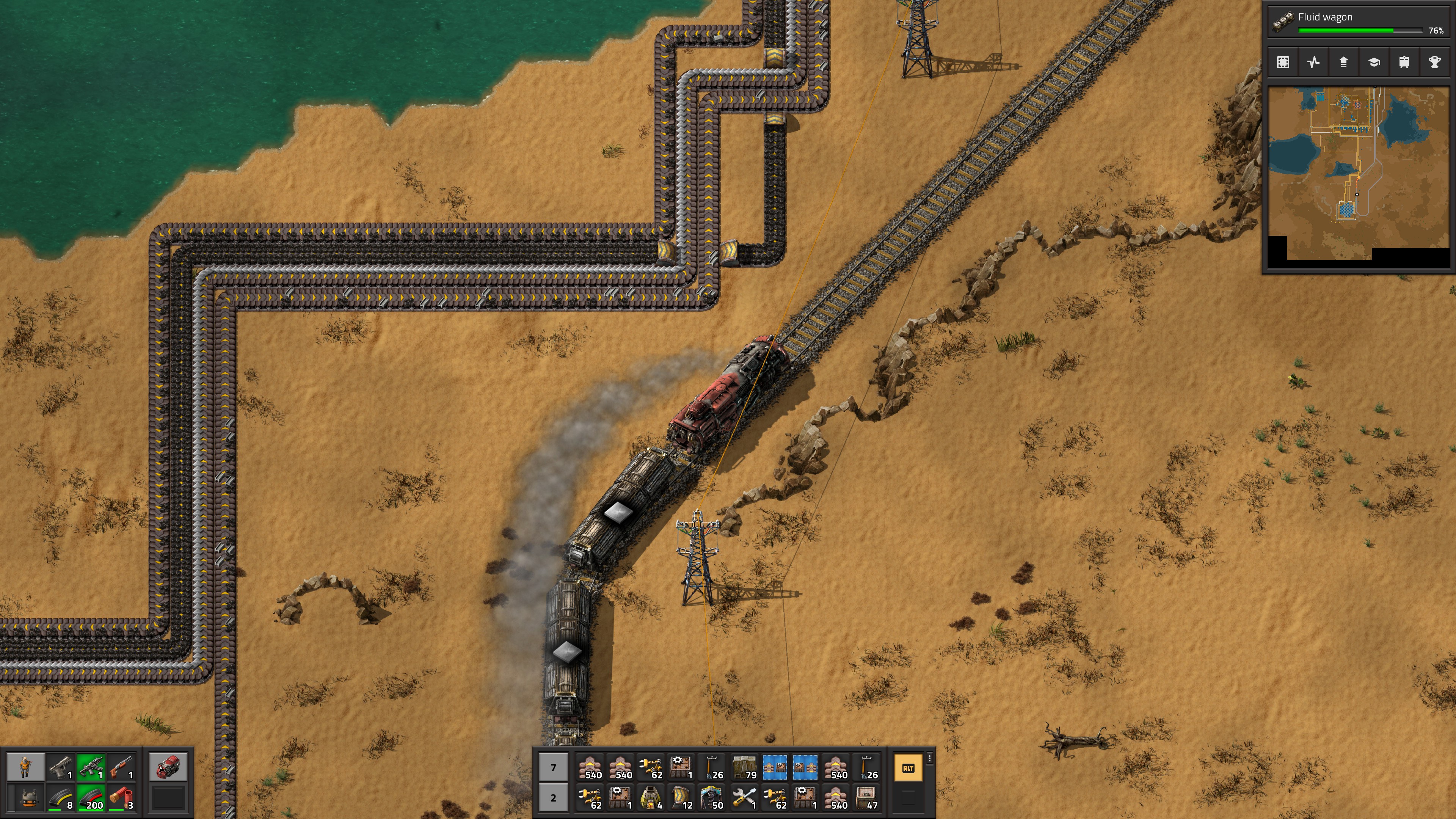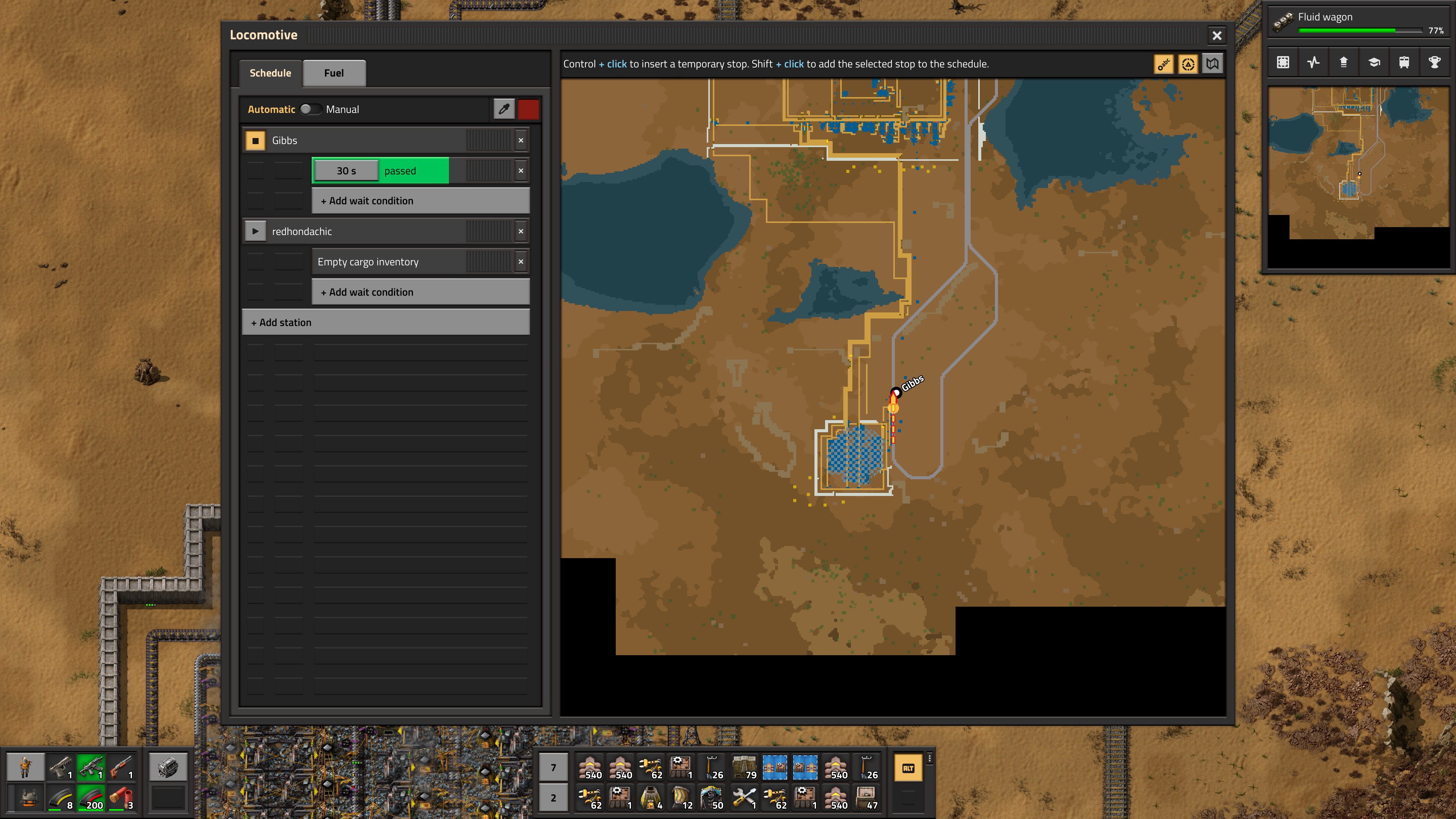
Choo-choo fellow Factorio train fans! Trains are a popular feature in any game (except perhaps FIFA), yet Factorio’s railways are an easily neglected aspect of Wube Software’s fantastically complex management sim. Primarily a method of transportation, they’re more intimidating to both manufacture and build compared to the more familiar transport belts. But a well-designed railway system can massively boost efficiency of your factory. Railways let you move huge amounts of resources far quicker than transport belts can, and can be deployed to boost areas where production is falling short.
In this Factorio train guide, I’ll take you through how to manufacture and construct your railways, how to schedule stops, and the best ways to make use of your iron horse. So let’s fire up the boiler and get this freight on the move.
How to build a Factorio train station
Building a railway in Factorio can be complicated, but the complexity depends largely on what you want the railway to do. If you want to use it purely to move around the map, then you only need to produce two items: a locomotive and a rail-track. The main purpose of Factorio’s railways, however, is for moving cargo, ideally automatically. For this, you’ll need more items:
- At least one locomotive
- Rail track (lots of it)
- At least one Cargo Wagon
- At least two train stops
How to build a train
In standard play, building a train in Factorio requires:
- 20 Engines
- 10 Electronic Circuits
- 30 Steel Plate
Locomotives are resource intensive to build, so it’s inadvisable to create an assembly line for them unless you have plentiful resources at your disposal, and/or require a many locomotives. That said, you should have assembly lines established for all their component parts, as they are all used frequently in general manufacturing. Here's how to get the items you need:
- Engines: Combine iron gears, iron pipes, and steel plate.
- Electronic Circuits: Combine copper cable and iron plate.
- Steel plate: Smelting five iron plate in a furnace.
How to manufacture rail track
In standard play, manufacturing rail track in Factorio requires:
- One iron stick
- One steel plate
- One stone
Rail track is simple to make, especially if you’ve established good production lines for stone mining, smelting iron, and steel plate. However, you’ll need a lot of it, so establish an assembly line for it (see image above for a simple example).
Keep up to date with the most important stories and the best deals, as picked by the PC Gamer team.
How to make cargo wagons
In standard play, manufacturing Cargo Wagons in Factorio requires the following:
- Ten iron gears
- 20 iron plate
- 20 steel plate
Like locomotives, Cargo Wagons are resource intensive, so you’re best building them manually unless you have plenty of resources to spare.
How to make Factorio train stops
In standard play, manufacturing Train Stops in Factorio requires:
- Five electronic circuits
- Six iron plate
- Six iron stick
- Three steel plate
An assembly line for train stops is not needed initially, but may become necessary if you significantly expand your rail network.
How to construct a simple freight railway
To build a railway in Factorio, first you must lay down your track. Tracks can be built in a straight line end-to-end, or in a loop. If you opt for the former, you’ll need locomotives at either end of the train so it can navigate both ways.
Once done, place your train stops where you, well... want the train to stop. The stop must be placed on the right-hand side of the track relative to the direction the locomotive is facing. Also, consider the length of your train when placing the stop, as you want to leave space for your Cargo Wagons to be unloaded. It’s worth putting your train with Cargo Wagons on the track at this point, so you can gauge how must space you need.
At this point you should consider constructing your stations. For basic functionality, any station should have three things:
- A method for loading and unload cargo.
- Either storage or further transportation for that cargo.
- A way to refuel the locomotive.
How to load and unload Factorio trains
Loading and unloading the train is achieved using inserters. You can align up to twelve inserters with one Cargo Wagon (six per side). Ideally, use either fast, filter, or stack inserters for loading and unloading. Trains carry huge amounts of cargo, so the quicker you fill their wagons, the better. Depending on what you want to do with the cargo, you should either have storage boxes ready to contain it, or transport belts prepared to convey the cargo for further production.
Finally, trains require fuel to run, so it’s worthwhile establishing a method of refuelling them while loading/unloading. This can be as simple as inserting coal into the locomotive from a storage box.
How to automate your train
Trains can be driven manually by sidling up to the locomotive and pressing 'Enter', to jump in the driver’s seat. But for efficiency’s sake, you want the locomotive to do the driving for you.
To automate a train, click on the locomotive, then select the 'Schedule' tab. Here, you can add stations to the train’s schedule, alongside 'Wait Conditions' that inform the train how long to wait at a station for. This could be for a set amount of time, or until its cargo wagons are full/empty.
Once your stops and wait conditions are set, you train should depart on its own. If you get a 'No path' error, however, that means something is preventing the train from comprehending the route. Check both the track and the stops to ensure they are all properly aligned, and ensure your train is able to get from one stop to another (such as having a locomotive at each end if the track is a straight line).
Everything else you need to know about trains in Factorio
So that's how to establish a basic railway setup in Factorio, but there are a few other important functions of railways you should know about.
Alongside solid cargo, trains can also be used to carry fluids, such as water and oil. To transport fluids, you need to manufacture fluid wagons for carrying the liquids and pumps for loading/unloading fluids. You can build pump stations in the same way you build a cargo station, only using pumps and pipes instead of inserters and belts.
If you want to create an expanded railway, with intersections and multiple trains, you’ll need to learn how to use rail signals to stop them crashing into one another. But rail-signalling is a whole thing on its own.
Railways can be weaponised by building the artillery cannon. One of Factorio’s most formidable weapons, the artillery cannon has huge range, and can devastate enemy structures with its shells. It is resource-intensive to build, however.
Finally, trains are dangerous: Unlike a transport belt, a speeding train will almost certainly kill the player if it collides with them, so once you’re train is in motion, be extremely careful when crossing tracks.
Rick has been fascinated by PC gaming since he was seven years old, when he used to sneak into his dad's home office for covert sessions of Doom. He grew up on a diet of similarly unsuitable games, with favourites including Quake, Thief, Half-Life and Deus Ex. Between 2013 and 2022, Rick was games editor of Custom PC magazine and associated website bit-tech.net. But he's always kept one foot in freelance games journalism, writing for publications like Edge, Eurogamer, the Guardian and, naturally, PC Gamer. While he'll play anything that can be controlled with a keyboard and mouse, he has a particular passion for first-person shooters and immersive sims.




